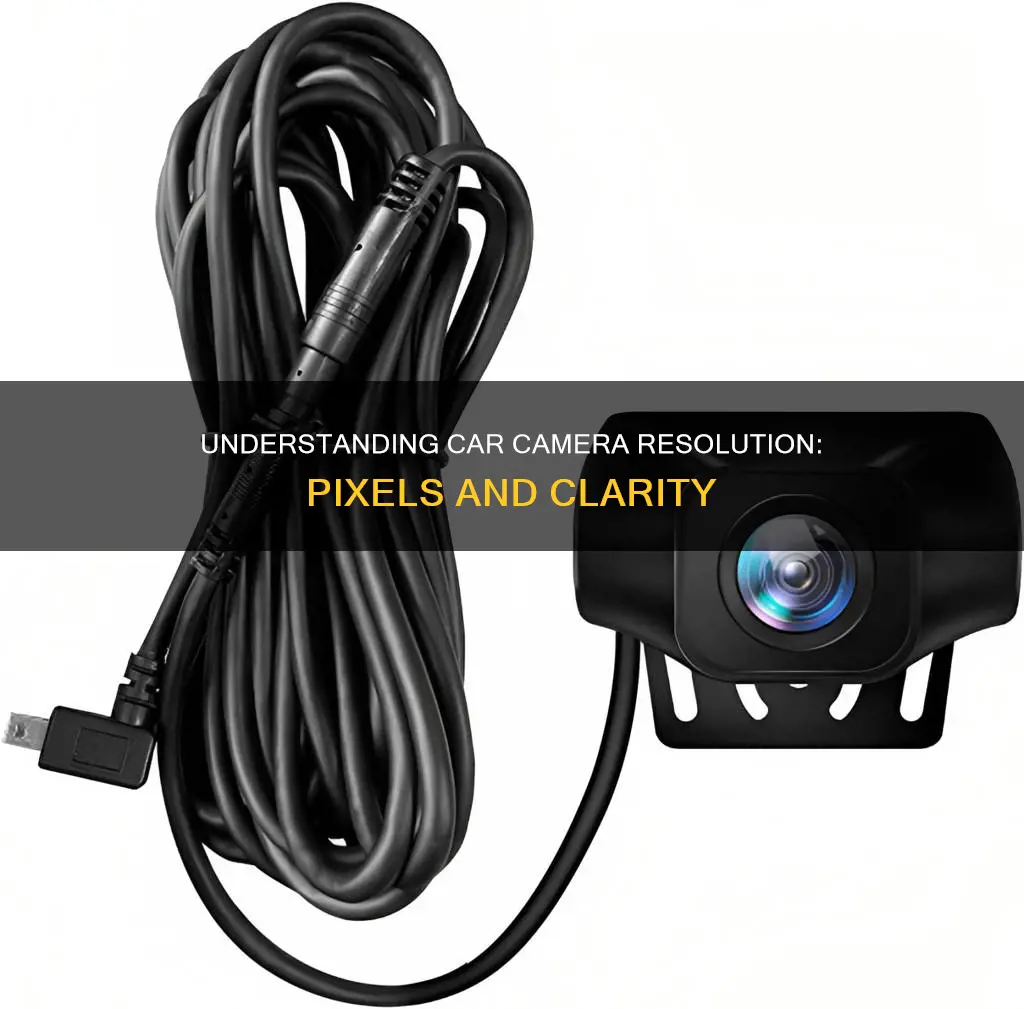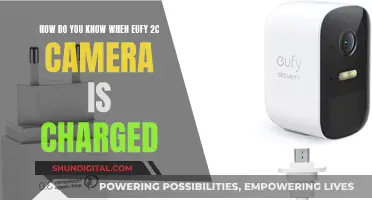
Car camera resolution is an important feature to consider when investing in a car or dash cam. The resolution of a car camera refers to the amount of detail the camera captures in its images and videos. The higher the resolution, the clearer and more detailed the footage will be, improving safety and navigation. This is particularly useful when trying to capture important details such as license plates, road signs, and facial features, which can be used as evidence in the event of an accident or incident. Car camera resolution is typically measured in pixels, with the most common video resolutions being 720p, 1080p, 2K, and 4K.
What You'll Learn

How to measure resolution
The resolution of a car camera, or any digital camera, is measured by the number of megapixels on the camera's sensor. This is denoted by a number followed by "MP". For example, a camera with a 24.1 MP resolution has a sensor with 24.1 megapixels.
The resolution of a camera can also be displayed as a multiplication sum, representing the number of pixels along the long side and short side of the rectangular sensor. For instance, a camera with a sensor measuring 6,000 pixels long on the horizontal axis and 4,000 pixels along the vertical axis has an image resolution of 6000 x 4000 pixels, or 24 MP.
When it comes to measuring the resolution of a car camera, it is important to consider the specific type of camera and your intended use. For example, dash cams typically offer video resolutions ranging from 720p to 4K. The higher the resolution, the clearer and more detailed the footage will be, making it easier to identify important details such as license plates, street signs, and faces in the event of an accident or incident. However, higher resolutions also require more storage space and a more powerful processor to handle the video files.
In addition to the total number of megapixels, the density of pixels on a camera's sensor can also impact the resolution and image quality. A larger sensor can house more megapixels, resulting in a higher resolution. However, the size of individual pixels also plays a role, with smaller pixels generally providing better resolution.
It is worth noting that the resolution of a camera is just one factor influencing image quality. Other aspects such as pixel size, sensor size, lens resolution, lighting conditions, and lens quality can also affect the overall image sharpness and clarity.
Mastering Camera Focus for Sharp Distance Photography
You may want to see also

The impact of resolution on image quality
Resolution plays a significant role in determining image quality. The resolution of an image refers to its size, measured in pixels. When we talk about the impact of resolution on image quality, we are essentially discussing the amount of detail and clarity captured in the image.
Higher resolutions mean a greater number of pixels per inch (PPI), resulting in more pixel information and creating a crisp, high-quality image. This is especially important when printing images, as a higher resolution will ensure a sharper and more detailed output. For example, professional printers often require images with a resolution of 600 PPI or higher.
On the other hand, images with lower resolutions have fewer pixels. If these pixels are stretched too far, they can become visible, leading to a pixelated and blurry image. This is often noticeable when zooming in on an image. Additionally, when capturing images, it is always advisable to aim for the largest resolution possible, as it is easier to reduce the size of an image than to enlarge it without losing quality.
Furthermore, the resolution of a camera can impact its functionality. For instance, a car camera with a higher resolution can provide a clearer view of surrounding vehicles, making parking easier and safer. It can also enable features like scratchless parking, cruise control, and night vision.
It is worth noting that resolution is not the sole determinant of image quality. Factors such as lighting conditions, display quality, and camera specifications, including lens, sensor size, and image stabilization, also play a significant role in the overall image quality.
Understanding Raw Camera Link Data: Unlocking the Power
You may want to see also

How to choose the right resolution
Choosing the right resolution for a car camera is important to ensure you get the footage you need. Here are some factors to consider when selecting the appropriate resolution:
Purpose of the Footage
If you plan to use the footage only for online sharing or sending via email, a lower resolution is sufficient. However, if you intend to print the photos or require clear details for evidence or safety purposes, opt for a higher resolution. It's generally recommended to shoot at the highest resolution available, as you may want to crop or zoom in on specific areas without losing image quality.
Print Size
The intended print size of your photos will determine the necessary resolution. For example, if you want to make a 10- by 13-inch print, you would need a minimum of 11.7 megapixels.
Camera Capabilities
Consider the camera's image sensor size. A larger image sensor can generally produce higher-quality photos, even with fewer megapixels of resolution. If you plan to make large prints, look for a camera with a high maximum resolution. Conversely, if you only need small prints, a camera with average resolution can save you money.
Lighting Conditions
High-resolution cameras may struggle in low-light conditions, as smaller pixels on sensors might not capture enough light, leading to increased noise and reduced dynamic range. If you often drive in low-light conditions, ensure your camera can handle such scenarios without compromising image quality.
Storage and File Management
High-resolution images require substantial storage space. Consider investing in high-capacity storage devices and implementing efficient organisational systems to manage your files effectively.
Editing Requirements
Editing high-resolution images demands powerful equipment and software. Ensure your computer has sufficient RAM and CPU performance, and invest in professional editing applications to handle the large files without crashing or lagging.
Lens and Accessories
To optimise the performance of your high-resolution camera, invest in high-quality lenses, tripods, and lighting systems. These accessories can be costly but are essential for capturing the best possible images.
When choosing a car camera, consider your specific needs and budget. While high-resolution cameras offer superior detail and accuracy, other factors like lighting conditions, storage, and editing capabilities should also be taken into account to make an informed decision.
Camaro: Subcompact or Muscle Car?
You may want to see also

The relationship between resolution and storage space
The impact of resolution on storage space can be significant. For instance, recording one hour of 1080p video typically consumes around 6GB of storage. So, if you drive for two hours per day, five days a week, you would need approximately 64GB of memory. If you have a higher resolution camera, such as a 4K dash cam, you may need a larger SD card to accommodate the increased storage requirements.
The frame rate also affects storage space. A higher frame rate will result in larger file sizes, as more data is being captured per second. For example, 1080p resolution at 60 frames per second will take up approximately twice as much space as 1080p at 30 frames per second.
Additionally, the length of recording time will impact storage requirements. If your dash cam is set to record continuously, it will use up more storage space than if it only records when it detects motion or an impact. Longer recording times will naturally require more storage capacity.
It's worth noting that the type of video file compression used can also significantly impact storage requirements. H.265 is a newer and more efficient compression format than H.264, offering up to 50% reduction in file sizes while maintaining or improving video quality. This means longer recording times on the same storage space, especially for high-resolution formats like 4K.
When choosing a car camera, it's important to consider the balance between resolution, storage space, and other factors such as frame rate and compression format. By selecting the appropriate resolution and storage capacity, you can ensure that you have sufficient storage space for your needs while also capturing the desired level of detail and quality in your footage.
Charging the Wimius Q4: A Step-by-Step Guide
You may want to see also

How resolution can be maximised
Maximising the resolution of your car camera is about more than just getting clearer images. It's about ensuring you have usable evidence when needed and being able to capture important details like license plates and facial features. Here are some tips to help you maximise the resolution and overall quality of your car camera footage:
Choose the Right Resolution Setting
The first step to maximising resolution is to select the appropriate resolution setting for your car camera. The recommended resolution setting for car cameras is at least 1080p Full HD. This setting provides a good balance between video quality and storage space, allowing you to capture crucial details like license plates. If your camera and storage capacity support it, you can opt for higher resolutions such as 1440p or 4K for enhanced clarity, especially when zooming in on details.
Understand Lighting Conditions
Lighting plays a significant role in the quality of your car camera footage. While high resolution helps, poor lighting conditions can still result in grainy or unclear videos. Understand the lighting conditions you'll be driving in, and use specific settings or modes on your camera to optimise video quality. For example, if you're driving at night, in fog, or in other low-light conditions, you may need to adjust your ISO setting to compensate.
Keep the Lens Clean
A dirty or smudged lens can significantly reduce the quality of your footage, regardless of your resolution setting. Regularly check and clean your car camera lens to ensure it can capture clear images.
Optimise Camera Positioning
The position of your car camera can greatly impact the quality of your footage. Install the camera in a central location on your windshield to ensure a wide field of view. Make sure it's not obstructed by objects or vehicle components like rear-view mirrors or window stickers.
Use the Right Frame Rate
The frame rate, measured in frames per second (FPS), also plays a crucial role in the smoothness of your video playback. A higher frame rate is particularly important when capturing fast-moving scenes on the road. A standard frame rate for dash cams is 30 FPS, but some high-end models offer 60 FPS for even smoother footage, which is beneficial at higher resolution settings.
Maintain Sufficient Storage Space
Running out of storage space can interrupt your recording and cause you to miss important footage. Regularly check your car camera's storage space and consider investing in a larger-capacity memory card if needed.
By following these tips and adjusting your camera settings to suit your specific needs, you can maximise the resolution and overall quality of your car camera footage.
Mirrorless Cameras: Focusing Secrets Unveiled
You may want to see also
Frequently asked questions
A good resolution for a car camera is at least 1080p (2 million pixels), which will provide a high-definition image. Higher resolutions like 1440p or 4K can further improve image clarity and are recommended if you want to capture small details such as license plates.
The main difference is the resolution of the video they produce. 1080p records at 1920 x 1080 pixels, while 4K records at 3840 x 2160 pixels, resulting in a much higher quality image but also larger file sizes.
The best resolution setting depends on your needs. If you want the highest quality video, choose the highest resolution available. However, consider storage space and battery life when selecting a resolution, as higher resolutions require more of both.
Determine your specific needs, such as whether you need a front or rear camera and your budget. It is recommended to use at least a 1080p Full HD setting to ensure critical details are discernable. Higher resolutions will improve image clarity, especially when zooming.







